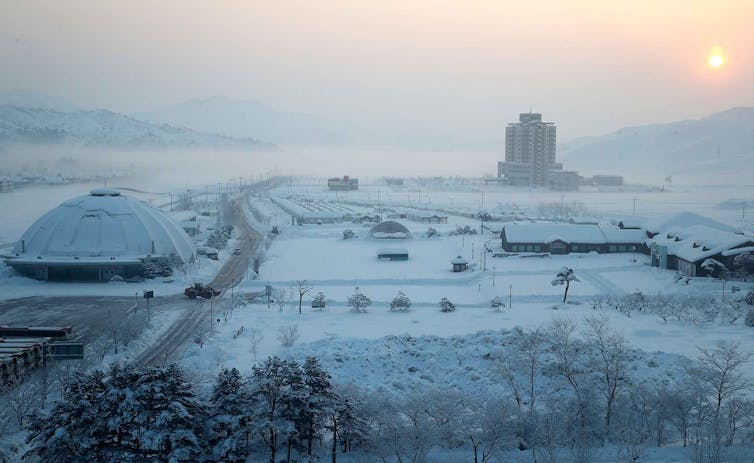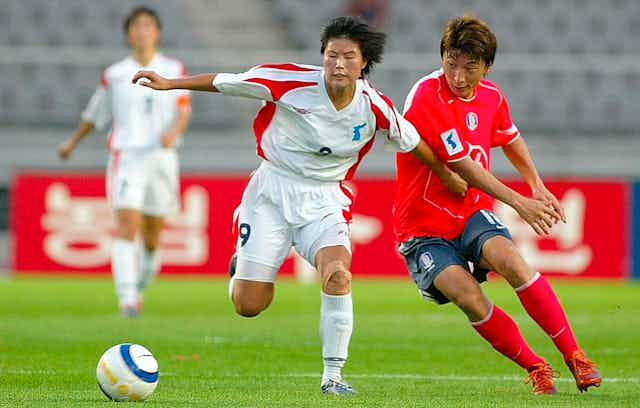North Korea’s ruler Kim Jong-un has now been in power for more than two years. He has largely stuck to the ideological principles that his father, Kim Jong-il, and grandfather, Kim Il-sung, had introduced and pursued, but there have also been some changes and surprises.
Although Kim bears a striking resemblance to his grandfather, Kim Il-sung (particularly his hairstyle and the straw hat he frequently wears) his public persona and style exude youth, vitality, energy – and occasionally, hint at more political openness. He surprised the world with his endorsement of Western cultural icons such as Mickey Mouse, Tigger and Winnie the Pooh. The latter were part of a July 2012 gala in honour of the country’s new ruler, broadcast on North Korean state TV.
At the end of last year, Kim Jong–un once again astonished the international community when he visted the country’s first ski resort in the rugged eastern mountains. The Masik Pass resort, which boosts several ski runs, two lifts, chalets, hotels, shops, and sleigh rides, is North Korea’s latest high-profile sports project. This is not the first time that North Korea’s Swiss-educated young ruler has been associated with expensive leisure facilities and new venues; in 2013 he visited the Munsu water park, with its gigantic slides and a horse-riding club. He was also seen and, of course photographed, in the modernised Rungna People’s Pleasure Ground, where he went for a roller coaster ride and to the cinema.
But the construction of a new ski resort is certainly the most ambitious and prestigious of all the country’s new and modernised facilities. It is intended to boost tourism and present the secluded country as civilised, cultured and advanced. In North Korea, however, building such a lavish ski resort despite scarce resources is not only about income generation and prestige. The country has a complex political agenda that accounts for the state’s interest in international sports.

Nation-building
Article 55 of North Korea’s constitution acknowledges that it is the responsibility of the state to provide physically fit people for the economy and the armed forces. The country’s official and more detailed sports policy is largely based on a speech given by Kim Jong-il in 1986, in which he announced that sport should be used as a public relations tool in order to foster international recognition and improve the country’s reputation abroad.
Kim Jong-un appears to share his father’s views, no surprise given that North Korea has been successfully participating in international competitions for several decades. For the international community, it is one of the rare occasions to encounter North Korean citizens.
During the Cold War, both Korean states used international sports events as a public stage for their ideological battles. Each tried to assert themselves as the true representative of the Korean people. They either did not attend in protest of the other’s presence, or, when they faced each other, the competition was fierce. That changed considerably after the 1988 Seoul Summer Olympics, which marked the end of their competition for legitimacy.
During the following two decades, political relations between the two Korean states slowly improved and moved the divided Korean Peninsula in a new direction. Most memorable among the many policy initiatives were the inter-Korean sport exchanges and “unification events”. They became important diplomatic tools of engagement, fostered a sense of unity on the divided Korean peninsula, and kept the dream of reunification alive for both northern and southern publics.
International competitions were frequently used to express both countries’ desire for peace, reconciliation and reunification. On several occasions, their teams marched together at opening ceremonies of the Asian and Olympic Games, used the name “Korea” and assembled behind a white flag with the shape of the whole Korean peninsula embroidered in a deep blue. In 2005, officials from the two Koreas even agreed to send a single, united team to the 2008 Beijing Olympics. After lengthy negotiations, however, the two countries failed to convene a unified team, as they were unable to agree on the selection criteria for athletes.
Since then, inter-Korean relations have deteriorated again and international sports events are used to pursue distinctively different political agendas. Due to North Korea’s international isolation the public display of state symbols abroad, particularly in the context of international sports spectacles, is crucial to the country’s continuous striving for recognition and respect.
In 2012, North Korea dispatched 51 athletes to the Summer Olympics in London who won a total of six medals (four gold and two bronze). Considering the country’s size and its deep poverty, North Korea arguably did very well, finishing 20th in the overall medal table, ahead of far larger, more affluent and more developed states such as Spain, Brazil, and South Africa. However, North Korea’s athletic prowess was overshadowed by a diplomatic row after South Korea’s flag was mistakenly shown on a screen next to the names and pictures of the DPRK’s women’s football team. This incident was hugely embarrassing and a high profile breach of protocol since North and South Korea are still technically at war, having signed only an armistice at the end of the Korean War in 1953.
The Masik Pass ski resort could soon become another political bone of contention between the two Korean states, as the South Korean city of Pyeongchang, close to the border with the North, is due to host the 2018 Winter Olympics. Thirty years ago, North Korea demanded to host a number of Olympic competitions of the 1988 Seoul Games, but talks between the two countries over the issue ended without resolution in the late summer of 1987. Although Pyeongchang’s bidding documents for the 2018 Winter Olympics claimed that the event would be a significant milestone in the reconciliation and reunification process between North and South Korea, so far, Southern politicians have categorically rejected any suggestion that the new ski resort could be an Olympic venue in 2018.
For both Korean states, the world of international sports provides a fertile network for contact and dialogue which they have both frequently used to send diplomatic signals, engage with each other, and contribute to rapprochement on the divided Korean peninsula. Although cooperation in international sports cannot work miracles, the Koreas’ persistent use of sport as a foreign policy tool shows that sport is anything but peripheral in their complex international relations.
Kim Jong-un’s interest in sports is therefore no surprise: he uses sports environments to shape and modernise his identity and image, boost tourism, foster an alternative discourse, gain international recognition, and overall generate a more positive reputation. Although North Korea categorically rejects and vehemently resists the ongoing globalisation process, the secluded state has appropriated the global sports stage in the name of the country’s national interests.

